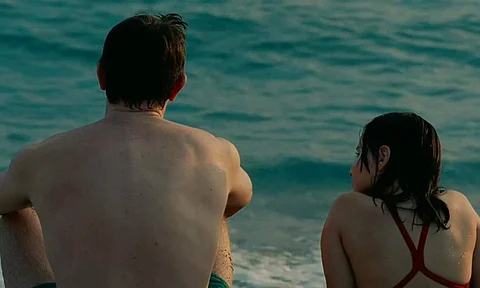

In Charlotte Wells’s Aftersun—streaming on MUBI—Paul Mescal and Frankie Corio play Calum and Sophie, a father-daughter duo vacationing in Turkey sometime in the 90s. He is barely into his 30s. She’s all of eleven. It’s a curious dynamic to the extent that fellow vacationers casually assume they are siblings. Mescal possesses a heavy guttural voice of a coach that does not betray his age, so when he says, “I am her father though” in a thick accent, the teenage traveller is quick to apologize and barely hides his shock. The film wheezes through the memories the duo shared and is an ode to the idea of temporal granularities shifting with time, sometimes twisting enough to completely change perspective years later.
Aftersun plays with the very relatable idea of childhood memories playing déjà vu which makes symmetry a valuable tool for Wells. Scenes transition impulsively from the daughter’s silhouette on the bed at night as the father smokes in the balcony to the father’s bare upper body as daylight knives through the room. The film begins with Sophie wielding a MiniDV and interviewing her father about his 11th birthday just days before he turns 31. We see the footage but not through it, for only later do we learn that it is a painful corner of Calum’s own childhood, a memory he wishes he could forget—we see a reflection of this image on a television monitor next to a stack of self-help books that Calum reads for a semblance of calm in his life. The focus puller does some heavy lifting throughout, blurring what is Sophie’s distorted absolute or sharpening the edges of parts of the vacation that she understands better as an adult and as a parent herself. What this essentially achieves is the blurring of the lines between truth and recollection, reality and imagination. Wells films something and we know it to be a point of view of the adult Sophie—who strobes in intermittently—and then we have the film within the film telling something about the individual points of view of the father and daughter at that point in time.
The narrative structure of Aftersun is a like a film projector jamming every fifteen minutes, pausing the joys of a vacation for a private moment of the daughter or vulnerable moment of the father and then returning to their varyingly remembered break from their tenuous lives. And every time this jams or every time a scene is played back in the DV as we assume the adult Sophie is doing either through the camcorder or in her head, the memory, like film, corrupts further, attaining a fresh grain registering not just the passing of time but also the growth of an individual. True to its nature, Wells shot it on 35mm with cinematography by Gregory Oke.
For Calum, Sophie is both a signal of hope for the future as well as a remembrance of a troubled past, his own trauma compelling him to overcompensate without the cushion of a young and free spirit. He struggles financially and is amicably separated from Sophie’s mother but the weight of parenthood doesn’t rest easy on his head. This is exacerbated by Sophie’s ability to understand him and her presence in his life better than he does. She is at a tender transitional age of 11, neither an innocent child unaware of her surroundings nor with the latent but ephemeral temerity of a rebellious teenager. She looks at other children and calls them kids, we learn that she possesses a propensity to be more discerning of her place in the family, in the world. She can talk deep like a college graduate encountering real life alone; she tells her father how they are all under the same sky and that makes her feel like they are all close no matter the distance.
Wells delves deep into the individualities and the rapport between the father and the daughter, the close ups effectively baring all their innermost conversations with their subconscious and how they register each other during physical togetherness but within the confines of solitude. Their bodies blocked at acute angles under a blue sky full of ubiquitous paragliders (Calum tells Sophie that she’s too young for it) captures this gulf between them perfectly. It helps that both the actors can hold closeups, their cards always showing without a hint of a slight legerdemain. Even Mescal’s bare back, stooped over his bed and the hollow cries can be searing. The film also uses its location cleverly, when we learn about Calum’s suicidal tendencies or his doubts about survival, his body threatens to fall off the side as Wells fills up ninety percent of the frame with the open sea.
The film begins with a warning about strobe lights and the adult Sophie in a rave with flashing luminescence piercing her body every second becomes a fitting metaphor to how she remembers the vacation with her father twenty years apart. It’s a playback of documentation in her mind, a palimpsest that has yellowed over the years with the past scribbles on it visible but illegible. Aftersun balances a time capsule of joy amidst decades of melancholy, a photographic memory preserving an archive of negatives in a dark room. Newly developed images litter the room and transcend time and space but they tell only part of the story, equal parts surviving and disappearing into a black hole.